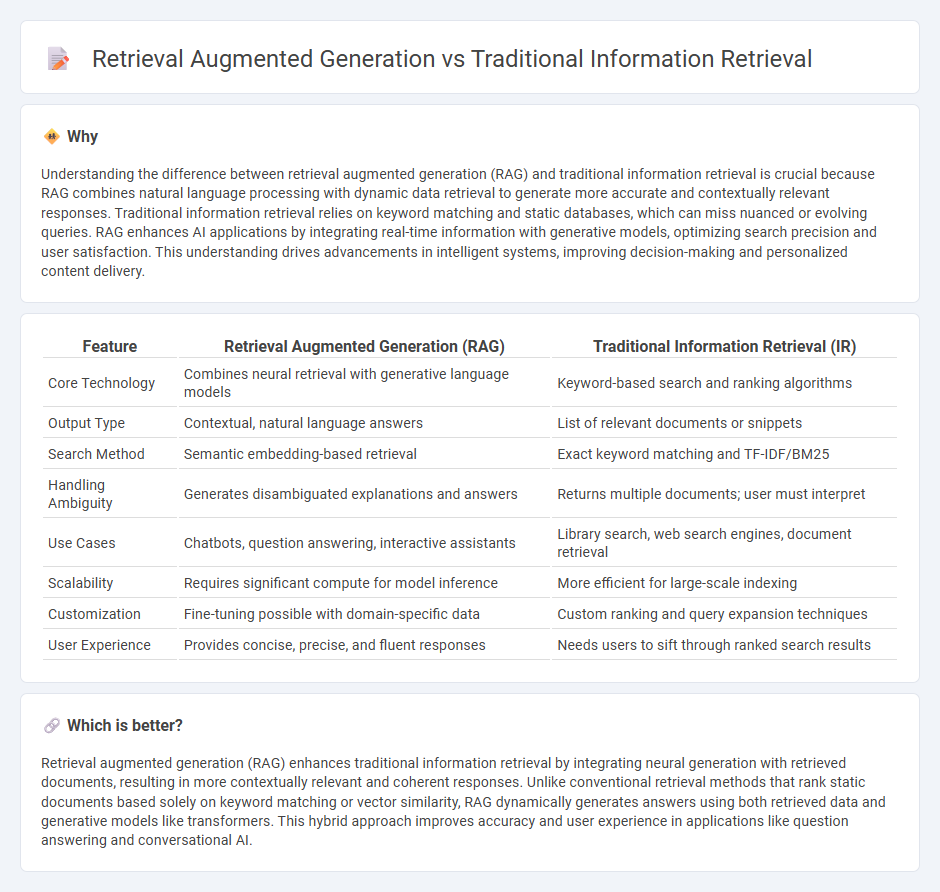
Retrieval augmented generation (RAG) enhances traditional information retrieval by integrating generative models with indexed databases, allowing for more contextually relevant and precise responses. Traditional information retrieval relies on keyword matching and ranking algorithms, often returning less nuanced or incomplete answers. Explore how RAG transforms data interaction and improves search accuracy.
Why it is important
Understanding the difference between retrieval augmented generation (RAG) and traditional information retrieval is crucial because RAG combines natural language processing with dynamic data retrieval to generate more accurate and contextually relevant responses. Traditional information retrieval relies on keyword matching and static databases, which can miss nuanced or evolving queries. RAG enhances AI applications by integrating real-time information with generative models, optimizing search precision and user satisfaction. This understanding drives advancements in intelligent systems, improving decision-making and personalized content delivery.
Comparison Table
| Feature | Retrieval Augmented Generation (RAG) | Traditional Information Retrieval (IR) |
|---|---|---|
| Core Technology | Combines neural retrieval with generative language models | Keyword-based search and ranking algorithms |
| Output Type | Contextual, natural language answers | List of relevant documents or snippets |
| Search Method | Semantic embedding-based retrieval | Exact keyword matching and TF-IDF/BM25 |
| Handling Ambiguity | Generates disambiguated explanations and answers | Returns multiple documents; user must interpret |
| Use Cases | Chatbots, question answering, interactive assistants | Library search, web search engines, document retrieval |
| Scalability | Requires significant compute for model inference | More efficient for large-scale indexing |
| Customization | Fine-tuning possible with domain-specific data | Custom ranking and query expansion techniques |
| User Experience | Provides concise, precise, and fluent responses | Needs users to sift through ranked search results |
Which is better?
Retrieval augmented generation (RAG) enhances traditional information retrieval by integrating neural generation with retrieved documents, resulting in more contextually relevant and coherent responses. Unlike conventional retrieval methods that rank static documents based solely on keyword matching or vector similarity, RAG dynamically generates answers using both retrieved data and generative models like transformers. This hybrid approach improves accuracy and user experience in applications like question answering and conversational AI.
Connection
Retrieval augmented generation (RAG) enhances traditional information retrieval by integrating external knowledge bases directly into the language generation process, enabling more accurate and context-aware responses. Traditional information retrieval focuses on fetching relevant documents or data from large databases, while RAG uses these retrieved documents to inform and guide the generation of text. This connection allows RAG models to combine the strengths of search engines with advanced natural language processing techniques for improved information synthesis.
Key Terms
Indexing
Traditional information retrieval relies heavily on indexing structured data to enable fast, keyword-based searches through large document collections by creating inverted indexes. Retrieval augmented generation (RAG) integrates advanced neural models with dynamic retrieval systems, where indexing may involve both text embeddings and contextual metadata to improve relevance in generating responses. Explore further to understand how indexing innovations drive the performance differences between these two approaches.
Query Processing
Traditional information retrieval relies on keyword matching and basic text indexing to process queries, emphasizing precision and recall from static document databases. Retrieval augmented generation (RAG) integrates advanced language models with real-time document retrieval, enabling context-aware, dynamic query understanding and response generation. Explore the latest advancements in query processing techniques to enhance information retrieval strategies.
Contextual Generation
Traditional information retrieval relies on keyword matching and document indexing to fetch relevant information from static databases, often lacking nuanced understanding of user intent and context. Retrieval Augmented Generation (RAG) integrates retrieval with neural generation models, enabling dynamic contextualization and more accurate, coherent responses by synthesizing retrieved documents with generative language capabilities. Explore in-depth how RAG transforms contextual generation and enhances search accuracy by visiting our comprehensive guide.
Source and External Links
Traditional IR vs. Web IR | PDF | Information Retrieval - Scribd - Traditional information retrieval (IR) involves searching within small, controlled collections of documents organized and indexed by experts, aiming to retrieve all relevant documents while minimizing non-relevant ones, unlike web IR which deals with vast, unstructured information open to the public.
Information retrieval - Wikipedia - Information retrieval is the science of searching for information in documents and metadata, with its early conceptual origins in the 1940s and development of automated IR systems beginning in the 1950s.
What is information retrieval? - IBM - Information retrieval is a field in computer and information science focused on finding unstructured data relevant to user queries from large collections, underpinning tools like library catalogs and web search engines.
 dowidth.com
dowidth.com